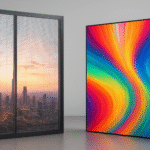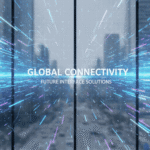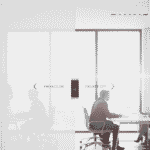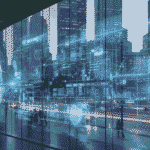Smart glass is the next big thing in modern architecture and interior design, thanks to the innovative technology behind PDLC Smart film. PDLC switchable film is a game-changer in the industry, offering superior privacy and energy efficiency while providing an unparalleled level of convenience. In this article, we’ll delve into the technology behind PDLC Smart film and how it works to provide you with everything you need to know about this cutting-edge technology.
About PDLC Smart Film
PDLC switchable film is a revolutionary technology that allows users to switch between transparent and opaque states using a remote control or a smartphone app. The technology behind the film is based on the principles of liquid crystal display (LCD) technology, which has been used in electronic devices like televisions and computer screens for several decades. PDLC Smart film is now widely used in various applications such as office partitions, conference rooms, and residential windows.
Types of PDLC Smart Film
There are two types of film
- Self-adhesive: This type of film can be easily applied to existing glass surfaces without the need for professional installation.
- Non-adhesive: This type of film requires professional installation and can be used for larger applications.
How PDLC Smart Film Works?

The film consists of two layers of transparent conductive film coated with a liquid crystal mixture. The film blocks light when the liquid crystal molecules are oriented in a random pattern in an opaque state. Applying an electric current aligns the liquid crystal molecules, making the film transparent and allowing light to pass through. PDLC film can switch between opaque and transparent states in a matter of seconds, making it an ideal solution for privacy and energy efficiency.
Advantages of PDLC Smart Film
It has several advantages over traditional glass, including
- Provides privacy on demand: It allows users to switch it on or off using a switch or remote control, providing privacy as needed.
- Increases energy efficiency: It reduces the amount of heat that enters a building during hot weather, resulting in lower electricity bills.
- Protects against harmful UV rays: It safeguards furniture, artwork, and other valuable items from the damaging effects of UV rays, prolonging their lifespan.
- Enhances security: It provides an additional layer of protection to windows and doors, withstanding impact and deterring break-ins.
- Reduces noise pollution: It reduces noise levels by up to 40%, making it ideal for use in homes, hospitals, and offices.
- Requires minimal maintenance: It is easy to clean and scratch-resistant, making it ideal for high-traffic areas.
- Adds aesthetic appeal: It is customizable with graphics, patterns, or logos to complement any room’s decor.
- Offers versatility: You can apply it to any glass surface, such as windows, doors, partitions, and skylights, making it suitable for any setting, including schools, homes, hospitals, and offices.
Applications of PDLC Smart Film

PDLC Switchable film offer various applications in different industries due to their versatility and distinct properties. Below are six common uses of these technologies:
- Residential Privacy Solutions: Homeowners can use film to provide privacy and control the light entering a room. You can apply it to windows, shower enclosures, and room dividers, making it an ideal choice for modern homes.
- Luxury Hospitality: High-end hotels and resorts can use switchable glass to create an elegant and sophisticated ambiance. You can use it in partitions, doors, and windows to enhance privacy and comfort for guests.
- Commercial Settings: Commercial buildings, such as conference rooms, office partitions, and storefront windows, can benefit from film and switchable glass to improve privacy and energy efficiency.
- Automotive Industry: The automotive industry widely uses switchable glass to improve visibility and reduce glare. It can also enhance privacy and security for passengers.
- Healthcare Facilities: Medical facilities use film and switchable glass to provide privacy for patients and control light levels in operating rooms. These technologies help create a comfortable and safe environment for patients and staff.
- Retail Displays: Retailers use switchable glass to create an interactive and engaging shopping experience for customers. You can apply it to storefront windows, product displays, and promotional booths to showcase products and enhance brand awareness.
Overall, PDLC Smart film and switchable glass have transformed the use of glass in various applications. Their unique properties make them an excellent choice for enhancing privacy, controlling light levels, improving energy efficiency, and creating innovative design solutions.
PDLC Smart Film Installation
The installation is a straightforward process that requires a few simple steps.
Here’s what you need to do
- Clean the Glass Surface: Before installing the film, clean the glass surface thoroughly to remove any dust, dirt, or debris. Use a soft, lint-free cloth and a mild cleaning solution to avoid damaging the glass.
- Measure and Cut the Film: Measure the size of the glass surface and cut the film accordingly. Leave an extra inch of film on all sides to ensure a perfect fit.
- Apply Adhesive: Apply a thin layer of adhesive to the surface of the glass. Be sure to apply the adhesive evenly to avoid air bubbles or wrinkles.
- Apply the Film: Carefully place the film on the adhesive-coated glass surface. Use a squeegee to remove any air bubbles or wrinkles and ensure a smooth, even finish.
- Connect the Wires: Connect the wires from the film to the switch or control system. Connect the wires properly to avoid any electrical issues.
- Test the Film: After installation, test the film to ensure it’s working correctly. Switch the film on and off to check the transparency and opacity levels.
Maintenance Of PDLC Film

Here’s what you need to do for proper maintenance:
- Regular Cleaning: Clean the film regularly using a soft, non-abrasive cloth and mild cleaning solution to wipe it gently.
- Avoid Harsh Chemicals: Do not use harsh chemicals or abrasive materials to clean the film.
- Handle with Care: Be gentle while handling the film and avoid bending or creasing it.
- Check for Damage: Inspect the film periodically for any signs of damage or wear and tear.
- Protect from Scratches: Avoid placing sharp or abrasive objects near the film and use protective covers if necessary.
- Professional Maintenance: Consider hiring a professional to maintain and repair the film for optimal performance and longevity.
Cost of PDLC Smart Film
The cost of PDLC film varies depending on the size of the application and the type of film used. Generally, self-adhesive PDLC film is more affordable than non-adhesive PDLC film and smaller applications are less expensive than larger ones.
Future of Film
- Increased Popularity: More industries recognize film’s unique properties and benefits, leading to increased popularity.
- Advancements in Technology: Constant technological advancements improving film’s performance and versatility.
- Expanded Applications: Adoption by more industries is expected to expand film’s applications, creating new opportunities in architecture, transportation, and other fields.
- Improved Cost Effectiveness: Wider adoption and improved production processes are expected to decrease the film’s cost.
- Environmental Benefits: Energy-saving properties lead to increased adoption, as industries and individuals prioritize sustainability and reduce carbon footprint.
- Integration with Smart Home Technology: Increasing integration with smart home technology allows for easy control and customization of privacy and lighting levels.
Final Thoughts
PDLC film and switchable glass revolutionize privacy and energy efficiency in modern architecture and interior design. Their innovative technology and versatility make them ideal for various applications. They are rapidly becoming a popular choice for enhancing privacy, controlling light levels, and improving energy efficiency. PDLC film and switchable glass will remain at the forefront of the industry for years to come.
Suppose you’re considering installing PDLC film or switchable glass in your home or office. In that case, it’s important to work with a professional installer to ensure a high-quality installation that meets your needs and budget.
FAQs
The lifespan of Smart Glass PDLC Film depends on several factors, including the quality of the Film and the amount of use it receives. Generally, PDLC Film can last between 5-10 years with proper care and maintenance.
The installation time for PDLC Film depends on the size of the application and the type of Film used. Generally, smaller applications can be installed in a few hours, while larger applications may take several days.
Smart Glass PDLC Film can help reduce energy consumption by controlling the amount of light and heat that enters a building. By blocking out excess sunlight and heat, buildings can reduce their need for air conditioning and other cooling systems, which can lead to significant energy savings.
Yes, PDLC Film can be applied to curved surfaces. However, the installation process may be more complex and require more time and effort.
Yes, PDLC Smart Window can be used for privacy by controlling the transparency of the Film. When the Film is switched on, it becomes opaque, providing complete privacy. When the Film is switched off, it becomes transparent, allowing light to pass through.
Yes, PDLC Smart Window is easy to clean with a soft, non-abrasive cloth and a mild detergent solution. However, avoiding ammonia-based or abrasive cleaners is important, as they can damage the Film.





